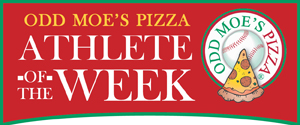Kirby Neumann-Rea: Time to get off the logo - at least symbolically
The Texas football coach’s words might have been the quote of the sport’s Thanksgiving weekend.
Steve Sarkisian wanted to avoid a repeat of the pathetic outburst earlier that day in Columbus, Ohio, where victorious Michigan Wolverines tried to plant a flag mid-field on the turf claimed by Ohio State University.
Buckeye players reacted violently. It was probably not the first time police anywhere have had to employ post-game pepper spray, but it was unseemly nonetheless.
My son Connal is living near Columbus, and was at a watch party for the Michigan-Ohio State game. I teased him about divided loyalties, given that his Grandma Rea was born a Michigander.
After the Wolverines’ shameful display, offending the OSU logo, I’m not so inclined to claim loyalty to the Blue. But then, OSU players pulled a similar stunt a few years ago in Ann Arbor, and I always kind of leaned toward Michigan State anyway.
This time around, Both Michigan and Ohio State have been slapped with $100,000 fines.
Later in the day Saturday, when Texas pulled out the win on Texas A&M’s home field, Sarkisian wisely stepped in. With police standing nearby, the coach herded his Longhorns away from the 50-yard line, declaring, “Off the logo.”
Ah, the logo. The quasi-riot in Columbus and the Texas coach’s prudent exhortations drew attention to what must be considered, be it NCAA playing fields or billboards and social media everywhere — the sanctity of the image.
Years ago, there was a “Dilbert” cartoon in which a consultant was tasked with devising with a distinctive company logo. He slurped his coffee, then set it down, pronouncing, “here’s your logo,” as he held up a napkin featuring a roughly circular caffeine stain.
The cartoon lampooned the fact that a variety of high tech businesses all had similar ring-shaped corporate symbols at the time, about 20 years ago.
It’s safe to say these were modeled after ouroboros, the Greek symbol of a snake or dragon devouring its own tail. A few years later, new and rebranding companies tended to favor the oval.
Figuring out the meaning of “logo” and related terms feels almost as futile as tail-devouring. Speaking as a writer, not an artist, logos, symbols and such have always fascinated me. Fueling that is this need for college coaches to tell their players to stay off their opponents’ logo.
Actually, I think “emblem” is a better term for that mid-field or mid-court image representing the host school.
Logo – from the Greek for “word” or “thought,” among other interpretations, springs from the 19th-century term logogram. In the 21st century, it feels this should be reserved for corporations.
“A company’s logo is an essential element of their brand and allows consumers to quickly identify their products,” writes Phoebe Sweet on the website imagerelay.com. “While many companies will update and change their logo to fit modern times, some well-known brands have maintained the same company logo design for more than a century. Using the same imagery to represent their brand for so long has allowed these popular logos and brands to become some of the most recognizable to people all around the world.”
There are distinctions to be made among symbol, logo and emblem. I have learned that “combination mark” is the term for use of the word and image together.
I’m not sure how to separate all that from “branding.” But in an age when branding has never felt more urgent, it seems important.
Designer Sagi Haviv said, “A logo is the period at the end of a sentence, not the sentence itself.”
In recent years, the term has taken on new meaning within my favorite sport of basketball. Long-ranger shooters such as Steph Curry have popularized the term “logo shot” – a basket scored from 35 to 40 feet out, on or near the mid-court logo.
Last week, I saw an online post from “Forgotten Oregon” — a photo of a Blazer guard, perhaps 6-4, trying to guard 7-1 Wilt Chamberlain. The photo was from the 1960s, and what stood out for me was not the hoops action, but the lack of logos.
Look at 1960s NBA photos: There’s no advertising, no massive corporate sponsorship imagery, no array of streaming electronic banners. You see hardly any signs at all.
That’s the single biggest change in NBA venues in the past 40 to 50 years. Advertising was also far less dominant in NFL and MLB venues, but you notice its absence more in the confined indoor arenas.
I remember watching a 1968 Seattle Sonics game on TV, played in Phoenix against the Suns, with a live rock band performing.
At the time, it struck me that this was Really Different, that there was something going on more than basketball. Ever since, the noise and lights and, now, automated music, are all part of the grand, glitzy spectacle that one has to expect at any such game. And everywhere, logos.
A contributor named Krishika, writing on the website Quora, puts it nicely:
“The word ‘logo’ has its origins in ancient Greek nor Middle English or Modern English. It comes from the Greek word ‘logos,’ which has a rich and complex set of meanings. In ancient Greek philosophy, ‘logos’ referred to various concepts such as “word,’ ‘reason,’ ‘discourse’ and ‘thought.’”
Rockpapersimple, a graphic design company, calls a logo “a simplified ad, the symbol face of the business or organization.” It adds, “A logo can be just an emblem, or a wordmark, or a symbol of both.”
An emblem “signifies a specific characteristic or quality of the company and can be used to identify it on its own.” Emblems thus “feature more detail than icons.”
Wordmarks “are what they say they are: the company name in an immediately recognizable typeface.”
Icons “are meant to convey abstract thought and … artistically summarize an action or operation.”
Stella Artois, Amstel and Bass, all beer companies, own among the earliest commercial logos still in use. They remain largely unchanged over spans of 200 to 700 years.
Among the oldest logos for existing companies are Twinings, American Red Cross, Johnson & Johnson, Lindt, Union Pacific and Prudential — all featuring little or no change ever.
The website Quora states: “Over time, the term ‘logo’ has been adopted and adapted into English and other languages to refer to a symbol, design or representation that identifies a brand, company, organization or concept. The modern usage of ‘logo’ as a symbol or emblem representing a business or entity emerged in the context of marking and branding during the 20th century.”
Brand. There is goes again.
Symbol, it seems, is an amorphous umbrella term for all these things. Or is it?
I suppose designer Marty Neumeier’s point adds some clarity: “A logo is not a brand — it’s only a symbol for a brand. A brand is much more than a logo.”
Sources say the terms aren’t interchangeable, then interchange them routinely.
“Sometimes there is a bit of confusion about icon, emblem, wordmark or logo,” states rockpapersimple, stressing the importance of distinguishing among them.
It feels like we ought to get our terms straight, what with college football players planting flags on each other’s logos.
I wear a Linfield Wildcat “emblem” on a sweatshirt. It feels like the right word for college and high school teams.
Or is it? Did they stop being “emblems” when college football became a business?
Whatever the case, respect is in order. College programs everywhere should put up motivational signs and even print sweatshirts or hats bearing coach Sarkisian’s words.
Perhaps some broader meaning can come from it. Why not?
“Off the logo!”
Kirby Neumann-Rea, the News-Register’s managing editor, enjoys books, craft beer, Celtic music and basketball.












Comments